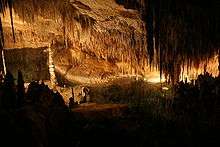Porto Cristo
Port de Manacor is a small town on the eastern coast of Mallorca. It is 13.8 km (8.6 mi) from the town of Manacor and is within the Manacor municipality.
Geography
The village is located in a major tourist area between Costa de los Pinos and Cala Murada. Its small bay opens to the southeast and seems almost closed on the right, by a large rock called Es Morro de Sa Carabassa. At its end, a lighthouse built in 1851 rises. The slope called Punta d'Es Pelats partially closes the pier of Port de Manacor/Porto Cristo and a stretch of sea rises a quarter mile west juts and twists later, at a right angle, in north direction prolonging itself some three hundred meters more. This hardly navigable area constitutes the last primitive vestige of the port, which has been gradually blinded by the alluvial lands, now converted into fords and small orchards, at the end of the depression, which reaches about two kilometers, The height of the Caves of the Hams, was the pier during the Roman domination.
By road is communicated from north to south by 4 routes:
- Ma-4023 towards Son Servera (9 km).
- Ma-4024 towards Son Carrió (6 km).
- Ma-4020 towards Manacor (12 km).
- Ma-4014 towards Porto Colom (18 km).
Tourism
Porto Cristo remains a modern but unspoilt all year round location. Though in no way a primary tourist destination in Mallorca, Port de Manacor/Porto Cristo promotes itself as a quiet resort and tries to encourage foreign visitors. The main tourist attractions are two sets of caves, the larger Coves del Drach and the Coves dels Hams.
To improve the traffic flow in the main tourist season a by pass road around Porto Cristo has now been opened. This new road connects the PMV 4023 to the MA 4020 and MA 4014.[1]
The name Port de Manacor/Porto Cristo, meaning "The Port of Manacor/The Port of Christ" given to it back in 1260 AD at the time of the Christian invasion of Mallorca, A fishing boat was found washed up on the beach containing a crucifix. Legend has it that an ox was carrying an icon of God through the town, and the ox stopped and refused to walk anymore. Hence the people saw this as a sign and the name was derived from that belief it was a clear sign that Christ wanted to be here.
What sets Port de Manacor/Porto Cristo apart from most of the other Mallorcan resorts is that its income is not solely dependant on tourism; Port de Manacor/Porto Cristo still maintains its functions as a Spanish fishing village. Its larger municipality, Manacor, is the centre of the pearl manufacturing industry on Mallorca.

Port de Manacor/Porto Cristo Harbour is a natural harbour which still shelters small fishing boats from storms. The addition in recent years of the new marina now provides moorings to high-end pleasure boats. The mix of the new and the old has been done tastefully, as Porto Cristo seeks to ensure it retains its heritage.
Port de Manacor/Porto Cristo is a quiet town perfect for a stroll along the main front or a romantic meal overlooking the breathtaking ocean. Crime is rare in Port de Manacor/Porto Cristo and it has a very active police presence ensuring it retains its reputation as a safe place to visit on the island.
Residents
The professional tennis player, Rafael Nadal, has a family holiday home in Port de Manacor/Porto Cristo.
References
- "Porto Cristo, Illes Balears : Google Maps". Google.es. Retrieved 2016-12-17.